
This Journalism Analysis will analyze The Guardian and Huffington Post from their publication history, production contexts, target audience and the similarities/differences of covering a related news topic.
Biography
The Guardian
History:
The Guardian is the UK’s national comprehensive daily newspaper, founded by John Edward Taylor on May 5, 1821. It was first known as the Manchester Guardian because of the head office location. Then the name was changed to its current one in 1959. The headquarters moved to London in 1964, but there are printing facilities in both Manchester and London (The Guardian, 2017).
Production Context:
The Guardian focuses on the international news report and is good at writing comments and analytic feature articles. The general public regards it as left-wing politics and holds an ‘independent’ view on international issues. According to Waterson (2018), The Guardian is becoming both the most trusted newspaper and the most read quality news outlet in Britain. Moreover, The Guardian is part of the Guardian Media Group (GMG), which is a British mass media company with a variety of media businesses, including The Guardian and The Observer. The group is owned by The Scott Trust Limited, which exists to permanently safeguard the financial and editorial independence of The Guardian (Conlan, 2008).
Target User Groups and their Demographics:
The primary readers of the newspaper are politicians, white-collar workers, and intellectuals. According to The Guardian (2010), 52% of the reader is male, and 48% is female. Their average age is 42.8. The average household income of its user is £40,816, which is higher than that of the UK internet user (£38,018). In terms of Education (highest level obtained), 19% of The Guardian user has Postgraduate qualification, 23% has Bachelor’s degree while only 9% and 15% of the UK internet user has these two qualifications. Moreover, the target audience group shows an interest in politics, exhibitions and international news (Reference, n.d.).
Huffington Post
History:
Huffington Post is a main US news site and aggregator blog which was founded in 2005 by Andrew Breitbart, Arianna Huffington, Kenneth Lerer, and Jonah Peretti. The original website is a liberal and leftist political commentary platform. Meanwhile, it also provides the public with a news aggregation service that is different from the traditional website Drudge Report (InfoGraphic, 2016).
Production Context:
Huffington Post is a news blog site with blog autonomy and media publicity, which is unique due to distributed news mining and WEB2.0-based social news communication. It has a positive role in aggregating the network community and promoting public communication. In 2012, Huffington Post became the first business-run US digital media company to receive a Pulitzer Prize (Flamm, 2012). In January 2019, Huffington Post ranked first in the eBizMBA’s list of the 15 most popular political websites (eBizMBA, 2019).
Target User Groups and their Demographics:
53% of the user is male, 47% is female. Huffington Post involves a young target group, 18-34 represents 45% of the whole audience, 18-24 takes 25%, 35-44 occupies 17%, only 13% is above 45 years old. Furthermore, the average household income of the audience is over $100k, and the average education of the audience is a Bachelor’s Degree or higher (Media Ant, 2018).
Comparative analysis
The Guardian (Story1): Meritocracy is a myth invented by the rich
By Nathan Robinson
Link: https://www.theguardian.com/commentisfree/2019/mar/14/meritocracy-myth-rich-college-admissions
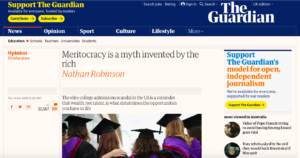
Huffington Post (Story2): We Can’t Talk About The College Admissions Scandal Without Discussing Mental Health
By Lindsay Holmes
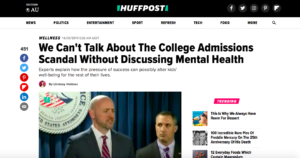
Journalistic writing and content production:
- Accuracy and source credibility of story content
Both of these two stories have high credibility, firstly because they are publications with a good reputation which means it is less likely to cover fake news. Secondly, the date of the articles and the date attached to the resources in the articles are all accurate. Meanwhile, no link is broken or dead. Thirdly, the two authors — Nathan Robinson and Lindsay Holmes can be found are both qualified editors who have written many articles for their news services respectively via checking their information on The Guardian and Huffington Post.
- Story forms
Story1 is an editorial which is more in-depth than a traditional news story. It reflects the author’s personal opinion about the college admission scandal, that is equality becomes a dream and meritocracy is only a myth created by the wealthy people. Roberts (2016) claims that the editorial helps develop an argument and sometimes even sway the views of the audience. Hence, Story1 is more likely to enhance readers’ participation, which in turn encourages them to think about the topic and write comments. Besides, I would suggest to using three subheads to increase the readability: ‘Meritocracy lies’ between paragraph 1 & 2, ‘Your family decides your education’ between paragraph 3 & 4, ‘The death of ‘American Equality Dream’ between paragraph 5 & 6. Story2 is a straight news story that follows the inverted pyramid style. The author reveals her core content at the beginning: the admission scandals is also relevant to mental health. Although Story2 is not as in-depth as Story1, the author finds a unique and easily neglected angle to cover the news, which gives it a real wow factor.
- Use of tags, embedded and related story links
In terms of tags, Story1 does not use tags. The page only shows a general catalogue of Education Section, where the audience can find this story belongs to US education. As a result, it would be much difficult to find the story by typing particular keywords such as ‘America’, ‘college admission’, ‘scandal’ on the homepage search engine.
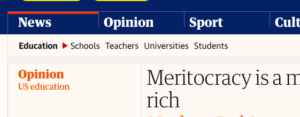
On the contrary, Story2 is searchable with specific tags that reflect its topic accurately. Meanwhile, this is also easier for readers to read other relevant articles.

Concerning embedded links, both two headlines are precise which could deliver the information or views to the audience in the first place.
In respect to related story links, I suggest adding one more link in the first paragraph of Story1. As the picture below shows, in the last sentence, the author gives the reader an example of a father helps his child cheat on tests. The audience would have a comprehensive understanding if put ‘faked a photo’ as a link phrase and add a new link about fake athletic profiles.

As stated by Martin (2019), link phrases should be short within 2-3 words. Therefore, in Story2, I would suggest changing these two long link phrases to a shorter one: ‘New Research’, ‘other research’ respectively.
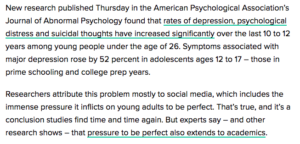
- Effectiveness and relevance of any audio-visual enhancements to the story text
Regarding Story1, there is only one image on the top. I suggest putting the second one in the middle. When talking about the comparison between public school and private school in paragraph 4, a graph as shown below could give an additional description of why learning environment of the private school is better than that of public school through statistics.
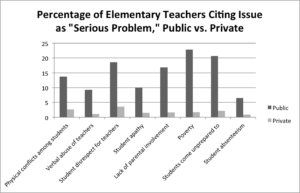
In addition, there is one photo and one video in Story2, which is related to the college admissions scandal. Nevertheless, Story2 mainly talks about the youth’s pressure. As a result, an image of wellbeing and peer pressure should be added to meet the theme.

Online delivery:
- Use of web and mobile platform interactive features
The masthead, logo, story categories all have a thoughtful design on both websites. The thumbnail images and story excerpts are both appropriate in Story1, but the former should be changed to a metal health-related picture in Story2. Also, a serious problem with Story1 is that there is no contact for the author. If the audience clicks the author’s name, a new page will jump out, which shows all stories the author has written so far instead of the author’s profile. Story2 has the same situation, but if readers pull down to the bottom and click the blue logo, they can go directly to the author’s twitter, which has some personal information.

- Use of social media and information sharing technologies
Both stories allow sharing via Facebook, Twitter, Email, LinkedIn, Pinterest, while Story2 can also be sent to Flipboard.
- User generated content
Comments are encouraged on The Guardian, but not on HuffPost. Users have to sign in or create their Guardian account before joining the discussion, whereas ‘suggesting a correction’ is allowed on Huffington Post.
Technical delivery:
- Usability factors
The main navigational menu, the subscribe button are both easy to find and operate on two platforms. Similarly, the text has high legibility with appropriate size and color. The newsletter registration field can be easily found on HuffPost but not on The Guardian.
- Functionality
All the links in the two stories are accurate and working, and the multimedia files are easily playable.
As stated by Bradshaw (2018), web writing is different from other traditional journalism, which needs reporters to focus more on brevity, adaptability, scannability, interactivity, and conversation. Therefore, in consideration of the user experience, journalists should weigh every detail of the story carefully before posting it online. From my perspective, although Story1 & 2 have their pros and cons of conveying the information, both of them are considered to be effective pieces.
Reference:
Bradshaw, P. (2018). Histories, futures and the changing business and technologies of online
journalism. In Online Journalism Handbook: Skills to survive and thrive in the digital age (pp.
72–98). London, UK: Routledge.
Conlan, T. (2008). Guardian owner the Scott Trust to be wound up after 72 years. Retrieved
on March 27, 2019, from The Guardian website,
https://www.theguardian.com/media/2008/oct/08/theguardian.theobserver
eBizMBA. (2019). Top 15 Most Popular Political Websites | January 2019. Retrieved on March
28, 2019, from http://www.ebizmba.com/articles/political-websites
Flamm, M. (2012). Digital media takes home a Pulitzer. Retrieved on March 28, 2019, from
CRAIN’S NEW YORK BUSINESS website,
https://www.crainsnewyork.com/article/20120416/ENTERTAINMENT/120419908/digital-
media-takes-home-a-pulitzer
InfoGraphic. (2016). The Huffington Post: The Story of How they Got to Where they are Today.
Retrieved on March 28, 2019, from https://www.infographicdesignteam.com/blog/the-
huffington-post-story/
Martin, F. R. (2019). MECO6925 Online Journalism, workshop 3, week 3: Link, tag, share, tweet
[Lecture PowerPoint slides]. Retrieved from
https://canvas.sydney.edu.au/courses/14465/files/5691527?module_item_id=480606
MEDIA ANT. (2018). Advertising in Huffington Post, Website. Retrieved on March 28, 2019,
from https://www.themediaant.com/digital/huffington-post-website-advertising
Reference. (n.d.). Who Is the Target Audience of The Guardian Newspaper?. Retrieved on
March 28, 2019, from https://www.reference.com/art-literature/target-audience-
guardian-newspaper-d82394beddc67c7
Roberts, J. (2016). Writing for Strategic Communication Industries. Columbus, OH: Ohio State
University Libraries.
The Guardian. (2010). Demographic profile of the Guardian site users. Retrieved on March 28,
2019, from https://www.theguardian.com/advertising/advertising-demographic-profile-
guardian-users
The Guardian. (2017). History of the Guardian. Retrieved on March 27, 2019, from
https://www.theguardian.com/gnm-archive/2002/jun/06/1
Waterson, J. (2018). Guardian most trusted newspaper in Britain, says industry report.
Retrieved on March 27, 2019, from the Guardian website,
https://www.theguardian.com/media/2018/dec/17/guardian-most-trusted-newspaper-
in-britain-says-industry-report





Be the first to comment